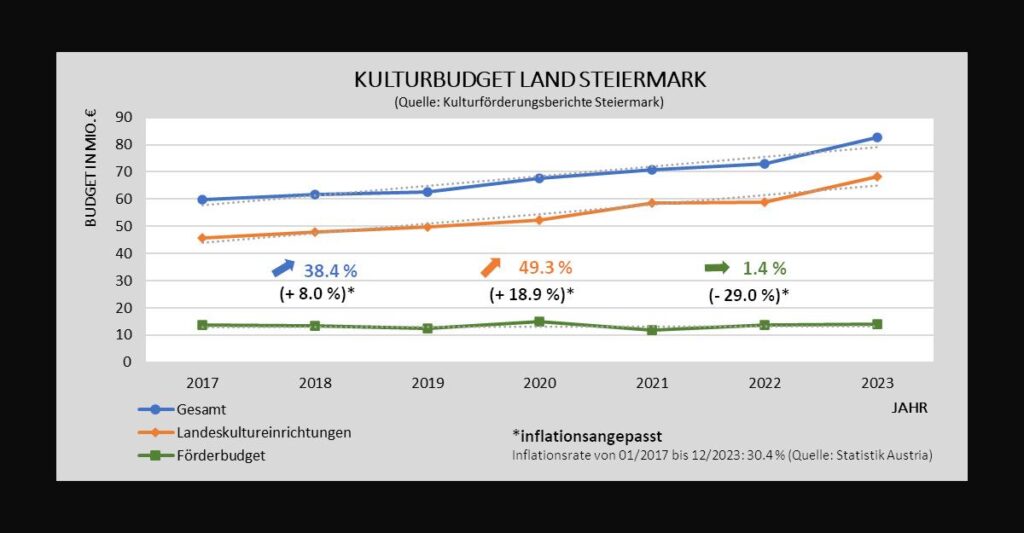28.01.2025: Even before the government meeting of the new Styrian state government, at which the details of the planned projects in the cultural sector are to be worked out, Styrian art and cultural actors are confronted with cuts in cultural funding.

Both those who submitted an application for annual funding for 2025 in September 2024 and those who applied for project funding in November 2024 are still waiting to hear back, even though the Styrian Arts and Culture Funding Act stipulates that the decision on an application must be announced within 14 weeks. In any case, the applications, including written reports from the Cultural Board of Trustees, have already been submitted to the responsible cultural officer Kornhäusl and are awaiting a decision from the provincial government.
One reason for this delay could be the fact that the Department of Culture is currently working with a provisional budget for 2025, which provides around 40% less budget funds for annual and project funding compared to 2024. We suspect that this shortfall is due to the omissions of recent years, in which despite massive increases in the overall cultural budget (2019: EUR 62.5 million, 2024: EUR 85 million), the cultural funding budget did not receive a corresponding structural increase, but was increased in individual cases as required.
It seems that cultural practitioners now have to foot the bill. As a consequence of the current budget shortage, we expect that applicants for funding will now receive a rejection or may be confronted with funding cuts despite having received funding for their work for years. This primarily affects (small) non-profit arts and cultural associations, which, as local cultural providers, enable lively cultural events for the local population and bring diversity to the Styrian cultural landscape. These initiatives usually operate on a cost-covering basis and do not have or cannot build up reserves, which is why even small changes in the cost structure very quickly lead to concrete losses: layoffs of employees, fewer commissions for artists, cuts in programs, event cancellations, closure of venues. The cuts will therefore also affect artists, who will not be able to realize their projects as a result or will be less frequently engaged by cultural associations.
Those who have a multi-year funding contract (2023-25) are not affected by the cuts for the time being. However, the amount of these grants was decided in 2022, even before the wave of inflation, and they have therefore indirectly experienced a significant reduction when taking into account the inflation of the last three years (around 20%). It is still unclear how the Province of Styria will proceed with the new multi-year funding agreements for the years 2026-28. The provincial government has still not decided on or published a call for tenders in this regard. Here, too, time is pressing due to the lengthy review process.
We fear that the developments described above will lead to an enormous thinning out of the Styrian art and cultural landscape. In combination with the tight budget situation at city and federal level, the risk of cuts is even higher. The austerity package and the budget freeze in the city of Graz represent a massive intervention in the city’s cultural budget (approx. -25%) and the federal government’s Department of Culture is also currently only granting applicants 50% of the previous year’s amount for annual funding.
The new state government has inherited a difficult legacy in terms of cultural funding. Since Christopher Drexler took office as head of the Department of Culture, spending on the state’s cultural institutions has increased by almost 50% (2017: EUR 45.7 million, 2023: EUR 68.3 million), but the budget for general euros), the budget for general arts and cultural funding and for popular culture has remained almost the same (2017: 13.7 million euros, 2023: 13.8 million euros) or has even decreased due to inflation and earmarking (e.g. for the so-called “Marterl-Call”).
Compensating for this unequal treatment of cultural actors must become a priority for the new state government in the cultural sector. Lighthouse projects can only be built on a solid foundation, which is why the basic cultural work of many art and cultural associations and artists must be maintained. This can only succeed if the financial resources are increased accordingly and structurally anchored in the budget. Against this background, we are delighted that the new Provincial Councillor for Culture, Kornhäusl, sees himself as an enabler in the cultural sector and we are relying on the words of the new Governor Kunasek, according to which the abolition of the ORF provincial levy is to be compensated for. Cultural policy is reflected in the distribution of public funds. With this in mind, old grievances must be cleared up during the upcoming government retreat and the subsequent budget negotiations in order to secure the cultural future of Styria.
“The nervousness in the Styrian cultural scene is growing. The government program already pays no attention to contemporary art and culture. Now those who are already the weakest in the funding chain are facing massive cuts. The future of the multi-year funding agreement is still unclear due to the lack of a call for proposals. A cut in the cultural budget threatens the cultural future of the province of Styria and would make the talks held over the last two years as part of the Cultural Strategy 2030 appear completely pointless. It is more urgent than ever to make the necessary political decisions quickly in order to avoid a further thinning out of the Styrian arts and cultural landscape.” (Lidija Krienzer-Radojević, Managing Director of IG Kultur Steiermark)
Source: IG Kultur Steiermark